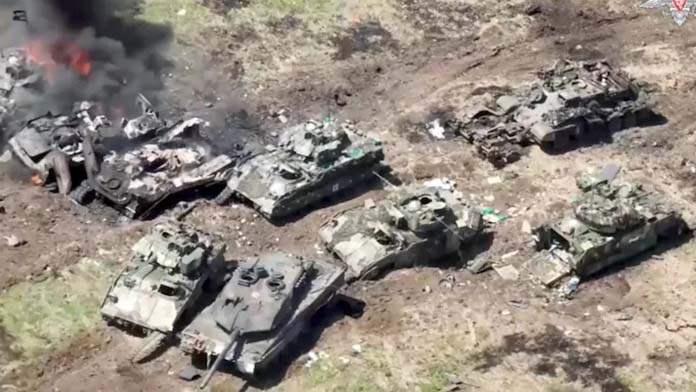Ukrainian President Volodymyr Zelensky has confirmed that his country’s long-awaited counter-offensive is under way.
Mainstream Western analysts are cheering on Ukrainian attempts to take back territory lost since Russia’s brutal invasion. But there will be a huge human cost, with only a slim likelihood that Ukraine will actually succeed.
Ukraine’s total dependence on Western arms and training shows the proxy-war nature of the conflict.
In the lead up to the counter-offensive whole Ukrainian units have been sent to Germany, the UK, and other NATO countries to be trained and equipped with NATO weapons and advanced warfare tactics.
Ukrainian Defence Minister Oleksii Reznikov has said Ukrainian soldiers have been taught “how to operate simultaneously together… among the different units” for offensive operation so tanks, fighting vehicles, artillery and infantry can work together. Australian troops have also been helping train Ukrainian soldiers in the UK.
In March Zelensky said that the counter-offensive relied on the West delivering support saying, “We are waiting for ammunition to arrive from our partners” as well as “tanks, artillery and long-range rockets”.
Ukrainian divisions have been supplied with German-made Leopard 1 and Leopard 2 tanks from Poland, Spain, Norway, Sweden, Finland and Germany itself, German Marder Infantry Fighting Vehicles, British Challenger-2 tanks and US Bradley fighting vehicles.
The main thrust of the counter-offensive was still to begin at the time of writing, with Ukrainian forces yet to force Russia back to its main defensive lines.
We can expect an absolute bloodbath through the deaths of Ukrainian and Russian soldiers, adding to more than 100,000 already killed.
Russia’s defensive lines are highly fortified with extensive anti-tank and anti-infantry minefields, anti-tank trenches, and infantry trenches criss-crossing hundreds of kilometres of contested territory.
Doubts
A stated objective of the counter-offensive is to cut off Russia’s “land bridge” that connects Russia to Crimea—an area annexed by Russia in 2014 which is crucial to the Russian Navy. But there are serious doubts about Ukraine’s ability to retake significant areas of territory.
The Financial Times reported that “behind closed doors, some top officials in Kiev have struck what one of them described as a ‘very realistic and very pragmatic’ tone, conceding that it is unlikely Ukraine will be able to retake all occupied land from Russia.”
In the first weeks of the counter-offensive Ukraine quickly lost a number of Bradleys and Leopard 2 tanks.
Western officials told The Guardian there would be “grinding costly warfare likely for many months to come”. The war has become a war of attrition between two armies dug into trenches that resemble the First World War.
And even if Ukraine were to threaten to take Crimea, there are fears Russia would use “tactical” nuclear weapons to avoid outright defeat—some of which are being positioned in Belarus.
Along with the death toll, the environment has suffered enormously, with the Kakhovka Dam, one of the largest dams in Europe, being blown up and wreaking havoc for hundreds of thousands affected by the flood waters.
Whilst Russia is likely responsible, Ukraine’s own propensity for environmental destruction in the name of military gains should not be forgotten.
The Washington Post published evidence from US intelligence documents released as part of the Discord leaks that show the US knew Ukraine was planning the sabotage of the Nord Stream gas pipelines, which may be the largest ever methane leak into the atmosphere in a single event.
The West’s concerns are not with the lives of ordinary Ukrainians, but rather to secure their own power in an increasingly contested world.
The US wants to see Russia weakened militarily, economically, and geo-politically, and to see NATO allies further wedded to US foreign policy.
It is also hoping to send a message to China about the costs of challenging US power. In early June US Secretary of State Antony Blinken said explicitly, “we believe that Beijing is taking notice that, far from being intimidated by a forceful violation of the UN Charter, the world has rallied to defend it.”
The Australian government is likely to announce further weapons deliveries to Ukraine at the NATO summit in July, on top of over $500 million in military aid so far.
Instead of sending more weapons to continue the slaughter and fuel the war, Australia should be pushing the US, Russia, and Ukraine to negotiate an end to the conflict.
We need to build an anti-war movement to oppose Australia’s support for the war as well as the more than $368 billion going towards AUKUS and nuclear submarines—which are part of preparing a possible war with China.
By Luke Ottavi






